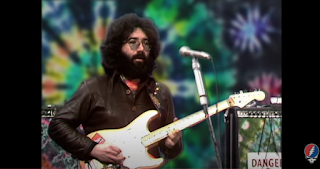Blowin’ Minds in the
Rhein: an excerpt from EUROPE 72 REVISITED
An
upbeat “He’s Gone” with two stinging Jerry solos ignites set two. The Goin’ where
the wind don’t blow so strange bridge isn’t part of the song yet, but these
neophyte versions of “He’s Gone” are a treat to listen to. Picking up off their
excellent previous set performance of “Next Time You See Me,” the band digs
into “It Hurts Me Too.” Pigpen’s channeling the pain and Jerry’s bending
strings and draining all the blues his guitar can muster. After “El Paso,” the
Dead transport Dusseldorf to a place where mankind has never been before.
Liftoff
is smooth as the Grateful Dead enter the celestial space of “Dark Star.” The
optimistic mood shifts as the music becomes dark and heavy. The band’s advancing
rapidly without a compass. Gravity, time, and reason are suspended. The sounds
lead the jam into a black hole. The band rallies with furious playing to find
their way back to the melody line. As Jerry sings, his voice grabs and hangs onto
the first word, “Darrrrrrk star crashes.”
“Shall
we go, you and I while we can? Through the transitive nightfall of diamonds,”
sings Jerry, and then the Dead open the trapdoor to another universe. They are
way out there, floating trillions of miles from Mother Earth. Phil’s in his
glory, guiding the symphony with bass runs and bombs. Garcia’s noodling lights
up the sky like a crowded constellation. Billy and Phil push, pull, and stretch
the musical landscape. Garcia’s guitar velocity becomes terrifying. We are
headed toward an abyss enveloped in a vortex. Keith and Bobby add essential
stokes to the madness. Is this art, an experience, or an experiment? It’s all
three, a musical mind-melt of the highest degree in terrain that only the
Grateful Dead could navigate.
Imagine
a twenty-year-old German fan coming to this show in Dusseldorf on April 24.
Let’s call him Franz; the classic rock fan who has only heard a few Grateful
Dead songs on the radio. Franz would be expecting a rock and roll show where
the band leader whips the crowd into a frenzy as they introduce the band’s
anthems and then play them as they had in the studio: “Casey Jones,” Truckin’,”
and “Friend of the Devil.” That would be groovy.
But unless someone dosed Franz with some of Owsley’s
primo acid, listening to this “Dark Star” will be a bizarre experience,
possibly bordering on boring. This is the antithesis of giving the audience
what it wants. Even a European Deadhead in the crowd might be confused by this
outrageous musical exploration. Where did these guys get the balls to play this
kind of music in front of any audience?
The
Grateful Dead had an artistic drive and devotion that mirrored legends like Bob
Dylan and Miles Davis. Trusting and following their musical instincts was
paramount. If their records sold, or the audience enjoyed their live
performances, that was great. But these heroic performers weren’t going to be shaped
by the expectations of record producers or their fans. Dylan stood tall when he
went electric at the 1965 Newport Festival as he broke the hearts of those in
the folk movement who loved him. Miles Davis changed the direction of jazz with
his groundbreaking fusion album Bitches Brew, although many old-school
jazz fans and fellow musicians felt betrayed. Throughout their careers, Dylan
and Miles never flinched; they always followed their artistic instincts, and
the world of music is light-years the better for their conviction.

The
Grateful Dead never really had a Newport or Bitches Brew moment. They
benefited from not being as commercially popular as Dylan or Miles early in
their careers. Learning how to play as a band during the Acid Tests set the
Dead out on an unpaved road without speed limits, highway signs, or exit ramps.
And their rabid and unique fan base supported the band’s every move
unconditionally. But for the Dead to be playing this kind of music in front of
European audiences was beyond brazen.

Back in Rhinehalle, after twenty-five
minutes of “Dark Star” disorientation, Weir strums a familiar rhythm and sings,
“Me and my uncle, went riding down, South Colorado, West Texas bound.” Garcia’s
picking is attentive on this nice little version, but it doesn’t pull the band
out of the “Dark Star” vortex. However, upon return, the band can explore “Dark
Star” anew. With early hints of “Wharf Rat,” the jam takes a euphoric turn as
it moves rapidly in various directions. As if they’re peaking on a collective
trip, they pull out pieces of past jams and weave them together. There’s a
touch of everything in here: “Caution,” “The Eleven,” “Alligator,” “Other One,”
“Uncle John’s Band.” It even sounds like they’re time traveling and previewing
traces of future tunes like “Throwing Stones.” Anything’s possible in the “Dark
Star” framework.
After
fifteen minutes of further “Dark Star” disorientation, Garcia’s clearly playing
the song’s melody line. It sounds like Jerry’s headed towards the second verse,
but he flicks the switch and a mellifluous segue leads to “Wharf Rat.” They are
still deep in the haze as they glide through the “Rat.” Jerry sings sweetly on
this odd version that offers little in the way of jamming. A hypnotic spell has
been cast over Dusseldorf.
A
more appropriate title for the official release would have been “Blowin’ Minds
in the Rein.” Finally, the Dead rock the Rein with a “Sugar Magnolia,” NFA >
GDTRFB > NFA, “One More Saturday Night” finale. The best jam of that
grouping belongs to “Sugar Magnolia.” What a wonderful and weird evening it was
in Dusseldorf!
Field of Dreams meets Almost Famous in the thick of a global pandemic. A new novel by Howard Weiner, Covid Blues















